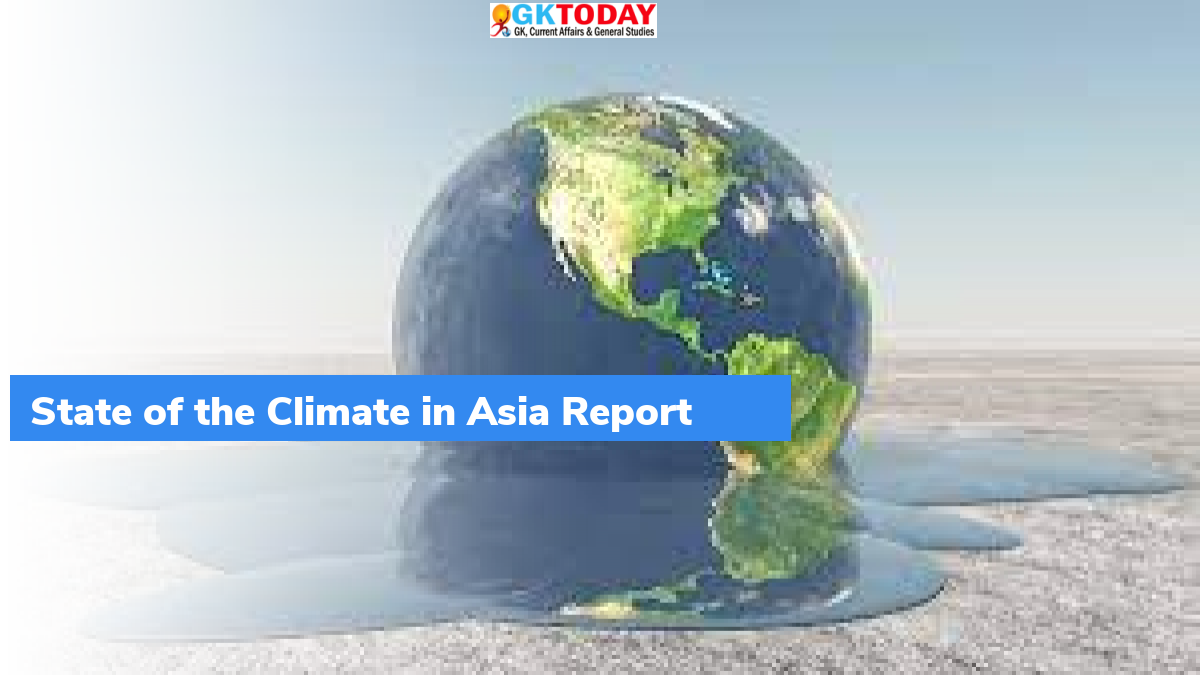State of the Climate in Asia Report
The State of Climate in Asia Report was published by the World Meteorological Organization in October 2021. The report provides an overview of ocean and land temperature, glacier retreat, precipitation, severe weather, sea level rise and shrinking sea ice. Also, the report examines the socio-economic impacts of COVID-19 in Asia.
Key Messages of the report
Temperature
2020 was the warmest year of Asia on record. The mean temperature was 1.39 degrees Celsius greater than 1981-2010. Also, there were notable heat extremes in certain regions. For instance, temperature of 38 degrees Celsius was noted at Verkhoyansk, Russia. This is the highest known temperature in Arctic circle.
Precipitation
The South Asian monsoon and the East Asian monsoon were unusually active. They caused floods, cyclones and landslides.
Ocean warmth
The average sea surface temperature in 2020 reached a record high in Pacific Ocean, Indian Ocean and Arctic Ocean. The ocean warming and sea surface temperature in and around Asia is increasing more than the global average. In Arabian sea, it is increasing at three times. Also, the sea surface temperature in the Arctic circle is also increasing at three times. The Barents Sea located in the Arctic circle has been identified as the climate change hotspot. Here, the sea ice loss is leading to more ocean warming.
Sea ice extent
The sea ice extent is the key indicator of climate change in polar regions. The ice extent of Arctic Sea was minimum in 2020 as compared to the previous years. The Northern Sea route and the Eurasian shelf were completely ice-free during 2020 summer.
Sea level
The sea level increased at 3.3 millimeters per year since 1990. The northwest Pacific Ocean and the north Indian Ocean sea-level increase are higher than the global increase.
Glacier retreat
The Himalayas and Tibetan plateau are home to 100,000 square kilometers of glaciers. They contain the largest volumes of ice in the world outside the polar region. The region sources ten important Asian rivers. The glacier retreat in the region is accelerating. It is projected that by 2050, the glacier mass is to decrease by 20% to 40%. This is to affect the livelihoods of more than 750 million people. This is to affect the regional water cycle, global sea level and local hazards such as avalanches and landslides.
Extreme Weather
Around 50 million people were affected due to 2020 floods in Asia. Also, it resulted in more than 5,000 fatalities. The economic losses due to extreme weather was 238 billion USD in China, 83 billion USD in Japan and 87 billion USD in India. The extreme weather events displaced millions of people. In May 2020, Cyclone Amphan displaced 2.4 million people in India and 2.5 million people in Bangladesh.
Agriculture and Food Security
According to the report, around 305.7 million people in South Asia, 48.8 million in South East Asia and 42.3 million people in West Asia are undernourished. The number of undernourished people in Asia has increased by 6% in West Asia and South-East Asia.
Mangroves
Between 1992 and 2019 the mangroves in the region decreased by 19%.
Forest Cover
Between 1990 and 2018, the forest cover in India, China and Vietnam increased. However, the forest cover in Cambodia, Myanmar and Democratic People’s Republic of Korea decreased.


